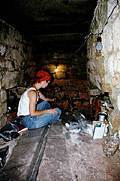
Revised June 4, 2001.
|
What may have been the tomb of a Maya king has been found about one kilometer from the center of ancient Copán. The discovery was actually made last August and announced by Seiichi Nakamura, a Japanese archaeologist working at a road construction site.
The tomb, together with an extensive building complex and dozens of other burials, was found by workmen digging in connection with the road construction project. Many of the artifacts recovered from this operation are already on display at the Copán site museum. The find came to the attention of Mesoamericanists again recently because of a posting on the newsgroup Aztlan and an online report by Science-Reuters, dated May 25, 2001, based on a press release by the Honduran ministry of tourism. The burial is definitely that of an elite individual, but no inscriptions were found in the tomb to name its occupant, and the burial site is at a signficant remove from the Copán Acropolis with its known royal burials. In addition to the supposed ruler's remains, the tomb contained those of a two-year-old child, painted red, and a woman variously described as a noblewoman and a servant. As reported by the London Independent on May 29, Nakamura asserted that both had been sacrificed in honor of the king. Offerings in the tomb included figurines, engraved seashells, ceramic vessels and copious amounts of jade, including at least one breastplate and earspools associated with the ruler. According to the press reports, the breastplates were engraved with "the Mayan god of war" and a "bedroll" — presumably, a pop or "mat" symbol of royalty. According to Nakamura, who has worked at Copán for one and a half years and in Honduras for eight, the ruler's remains date to the sixth century of the current era, which coincides with the reigns of the sixth through eleventh of Copán's known kings. Ruler 6 has been tentatively dated to around 485 by Simon Martin and Nikolai Grube in Chronicle of the Maya Kings and Queens, while Ruler 7, Waterlily Jaguar, is known to have assumed the throne at some point after 504. (Thus Ruler 6 is not a good candidate for the sixth-century occupant of the tomb.) According to Martin and Grube, Waterlily Jaguar ruled until at least 524, while Ruler 8 can only be pinned down to some point before 551, which is the known date of Ruler 9's accession to kingship. Ruler 10, Moon Jaguar, acceded in 553 and died in 578. Ruler 11, Butz' Chan, acceded in 578 and died in 628. Of these kings, all that is known about Ruler 8 and Ruler 9 (besides the accession date of the latter) is that they are depicted on Altar Q, a carved stone dynastic record. (See Quicktime movies of hieroglyphics expert David Stuart discussing Altar Q at Nova Online.) Waterlily Jaguar is known to have expanded Copán's Acropolis with a number of new structures, while Moon Jaguar built the magnificent Rosalila temple, a full-scale reconstruction of which is on display in the site's magnificent museum. Butz' Chan reigned for 49 years and was memorialized in a number of inscriptions by his successors. According to Agence France Presse, the new find is the sixth royal burial discovered at Copán since 1943, but four is a likelier number for previously known interments of rulers. The tomb discovered most recently, found in 1993 and uncovered in 1995, was almost certainly that of the dynastic founder, K'inich Yax K'uk' Mo'. (See "Copán's Founder" here at Mesoweb.) A tomb probably containing the wife of K'inich Yax K'uk' Mo', dubbed "The Lady in Red" for her covering of hematite and cinnabar, was also found 1993. (See the Early Copán Acropolis Program report at the University of Pennsylvania Museum website.) On June 4, 1989, archaeologists Ricardo Agurcia Fasquelle and William L. Fash, Jr., first peered into the tomb of Smoke Imix, the twelfth ruler of Copán, deep under Temple 26. |
 zoom
zoom
| In this photograph, taken in July, 2000, by Mesoweb's reporter, Lucia Henderson explains how she is completing the final excavation down to floor level in the tomb of Smoke Imix. |
|
A crypt beneath Temple 18, considered the mortuary shrine of Yax Pasaj Chan Yoaat, Ruler 16, was looted in ancient times.
Martin and Grube consider it likely that one of the three rulers Waterlily Jaguar, Ruler 8 or Ruler 9 is buried in the tomb known as Sub-Jaguar, which was found beneath the "dancing jaguar" sculpture of the East Court. Since both the Founder and the 12th ruler are known to have been buried in the Acropolis of Copán, it seems unlikely that an intervening ruler would have been buried about a kilometer away. But it should be noted that Ruler 10, Moon Jaguar erected stelae in a major building complex 1.6 kilometers from the center, now covered by the modern settlement of Copán Ruinas. it would certainly be worth a visit to Copán to observe the location of the new finds with respect to the central Acropolis and the justifiably renowned sculptures of the Great Plaza. And the new artifacts should make an interesting addition to an already superlative site museum. |
top - home